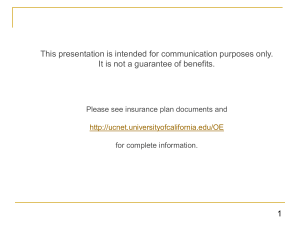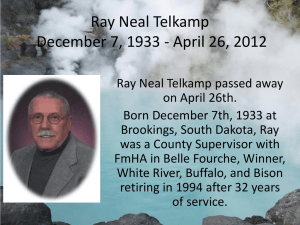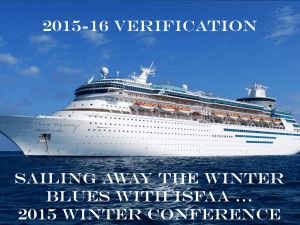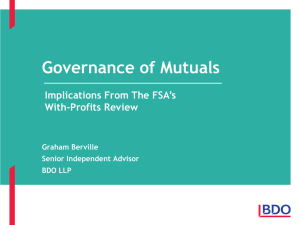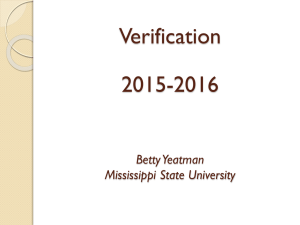Federal Update
advertisement
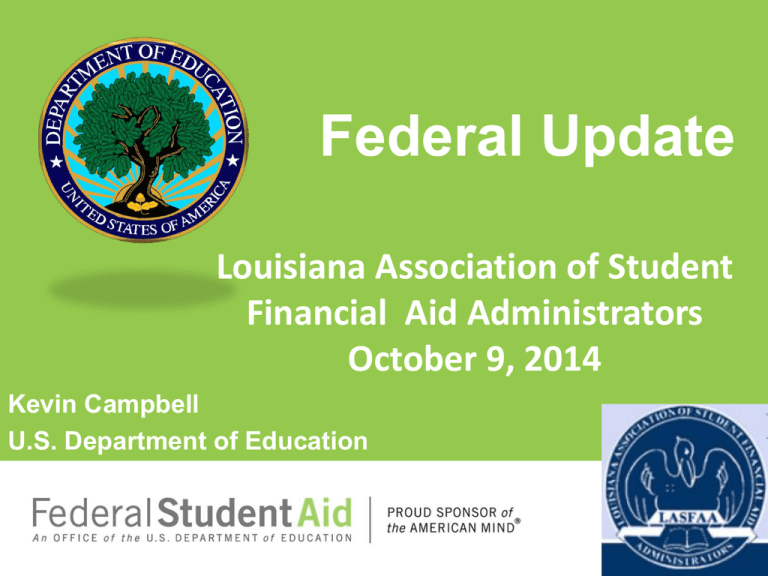
Federal Update Louisiana Association of Student Financial Aid Administrators October 9, 2014 Kevin Campbell U.S. Department of Education Copies of Presentation All FSA presentations will be made available to LASFAA next week for publication/dissemination 3 FSATRAINING.INFO • New website with FSA Training • • • • • • • • • • SAP Default Management Introduction to FSA COACH Consumer Info School Eligibility Student Eligibility EDExpress Recorded webinars And MORE! 6 Transition Period 7 National Student Loan Default Rates 15.0% Issue Year 2012 2013 2014 14.7% Cohort Default Rate 14.5% 14.0% 13.7% 13.5% 13.4% 13.0% 12.5% FY 2009 Official FY 2010 Official FY 2011 Official National Default Rates • On September 22, 2014, the Department electronically distributed FY 2011 3-Year official cohort default rates to all eligible schools • Time period for appealing FY 2011 3-Year Official Cohort Default Rates (34 C.F.R Part 668, Subpart N) begins on Tuesday, September 30, 2014 for all schools FY2011 CDR Calculations • Due to concerns with split-servicing, ED adjusted all three of the most recent official 3-year official CDRs for any institution that otherwise would have been subject to potential loss of eligibility due to FY 2011 rates • • excluded certain borrowers who defaulted on a loan but had one or more other Direct /FFEL loans in repayment, deferment, or forbearance for at least 60 consecutive days and that did not default during the applicable CDR monitoring period 60 consecutive days must have been between date loan on which borrower defaulted entered repayment and date when borrower defaulted on that loan Electronic Announcement – dated 9/23/14 Default Sanctions* (3-year rates) • Default Prevention Plans • 1st year CDR is equal to or greater than 30%: • Establish a default prevention task force; and • Develop and submit a default prevention plan to ED • 2 consecutive CDRs equal to or greater than 30%: • Revise and submit default prevention plan • ED may require specific adjustments/actions • 3 consecutive CDRs equal to or greater than 30%: • • Lose Direct Loan AND Pell Grant eligibility FY2011 or later CDR above 40% lose DL eligibility *ability to appeal/challenge rates GEN-14-03 • Provides a summary of: • Cohort Default Rate calculations • Consequences of high default rates • • CDR challenges, adjustments and appeals • 12 NOTE: An institution’s decision to stop participating in the Direct Loan Program does NOT eliminate the possibility that it will lose eligibility to participate in the Pell Grant Program. CDRs, and possible consequences, continue until no more of the institution’s former students enter repayment on their DL or FFEL loans taken for attendance at the institution Detailed discussion and chart on participation rate index challenges and appeals Default Management Resources • Default Prevention Resource Webpage • • www.ifap.ed.gov/DefaultPreventionResourceInfo/index.html Right-hand side of IFAP website • • Default Prevention questions can be sent to: • • Cohort Default Rate Guide defaultpreventionassistance@ed.gov Default Management Website www.ifap.ed.gov/DefaultManagement/DefaultManagement.html • Cohort Default Rate questions should be directed to: • • Default Prevention and Management Course • 13 (202) 377-4259; fsa.schools.default.management@ed.gov fsatraining.info (under training by topics) Perkins • • Perkins Loan Program Receives Automatic One-Year Extension The Perkins Loan Program, which has not received a Federal Capital Contribution (FCC) since fiscal year (FY) 2005 or cancellation reimbursements since FY 2010, received an automatic one-year extension through September 30, 2015. Unless Congress enacts legislation that specifically repeals the authorization of the program, the Perkins Loan Program will continue at least through the 2014-15 award year. 15 Interest Rates • The Administration worked with Congress to reach agreement on a plan to reverse the interest rate increase • New rate structure applies to all loans first disbursed after June 30, 2013 • Annual fixed rates based on 10 Year T-Bill plus add-on • Applies to loans first disbursed between July 1 and June 30 • Rate applies for the life of the loan 16 Interest Rates 2014-2015 • Undergraduate Students - Sub and Unsub • 4.66% (last year’s Sub and Unsub was 3.86%) • Add-on of 2.05% with cap of 8.25% • Graduate students – Unsubsidized Loans only • 6.21% (last year’s Grad Unsub – 5.41%) • Add-on of 3.60% with cap of 9.5% • PLUS Loans (parent and grad/professional) • 7.21% (last year’s – 6.41%) • Add-on of 4.60% with cap of 10.5% 17 18 Sequestration 19 Sequestration 20 Sequestration 21 22 Transcript Requests – 2014-2015 • Online IRS Transcript requests • Beginning with tax year 2013, once an online transcript request is validated, the IRS will return in real-time, a transcript in portable document format (pdf) through the new “Get Transcript Online” tool • • Tax filer can print/save/forward pdf transcript as needed Other Transcript Requests Tax filers can submit requests via - IRS2GO mobile app, online “Get Transcript by Mail”, automated phone tool (1800-908-9946), or paper Form 4506 or 4506-T • These request methods will result in a paper transcript • 23 DCL – GEN-14-05 Identity Theft – 2014-2015 • Beginning with the 2013 tax year, a tax filer who is not able to request an IRS Tax Return Transcript because of identity theft, will be able to call a special IRS toll-free number (1-800-908-4490) • Upon verification of identity, the tax filer can request the IRS provide a paper copy of an alternative document unique to identity theft issues (Tax Return Data Base View - TRDBV) • 24 The TRDBV is an official transcript that can be submitted to the school to meet verification requirements DCL – GEN-14-05 V4/V5 Tracking Results – 2014-2015 Issue: Provide an efficient method for FAAs to report the verification results for records selected with the V4 and V5 Verification Tracking Groups Solution: FAA Access has been updated to add Identity Verification Results functionality to allow FAAs to enter results individually or by file upload starting January 1, 2014 Electronic Announcements -11/13/13; 6/18/14 Federal Register 7/11/14 25 https://faaaccess.ed.gov V4/V5 Tracking Results – 2014-2015 Whom to report: student for whom school received an ISIR with a Verification Tracking Group of V4 or V5 AND for whom school requested verification documentation • Do NOT include students the school selected for verification of identity or high school completion status When to report: 60 days following the school's first request to the student to submit the required V4 or V5 identity and high school completion documentation • 26 changes to previously submitted Identity Verification Results must be updated within 30 days V4/V5 Tracking Results – 2014-2015 • Dropdown options/values will be #1-#5: #1 - Verification completed in person, no issues found #2 - Verification completed remotely, no issues found #3 - Verification attempted, issues found with identity #4 - Verification attempted, issues found with HS completion #5 - No response from applicant or unable to locate • If issues found with BOTH identity and HS completion, school will indicate issues found with identity (#3) 6/18/14 EA - provides information on when to use each value based on specific circumstances 27 V4/V5 Tracking Results – 2014-2015 Whom to report: student for whom school received an ISIR with a Verification Tracking Group of V4 or V5 AND for whom school requested verification documentation • Do NOT include students the school selected for verification of identity or high school completion status When to report: 60 days following the school's first request to the student to submit the required V4 or V5 identity and high school completion documentation • 28 changes to previously submitted Identity Verification Results must be updated within 30 days V4/V5 Tracking Results – 2014-2015 • Dropdown options/values will be #1-#5: #1 - Verification completed in person, no issues found #2 - Verification completed remotely, no issues found #3 - Verification attempted, issues found with identity #4 - Verification attempted, issues found with HS completion #5 - No response from applicant or unable to locate • If issues found with BOTH identity and HS completion, school will indicate issues found with identity (#3) 6/18/14 EA - provides information on when to use each value based on specific circumstances 29 Statement of Educational Purpose • 14-15 Statement of Educational Purpose (In Person) …the Federal student financial assistance I may receive will be used only for educational purposes… • 14-15 Statement of Educational Purpose (Notary) …the Federal student financial assistance I may receive will only be used for educational purposes… (See FR 6/13/13) • 15-16 Statement of Educational Purpose (In Person and Notary) …the Federal student financial assistance I may receive will only be used for educational purposes… (See FR 6/25/14) 2015-16 Verification • Non tax filers • If an institution questions a claim that the individual is not required to file, must require applicant to submit a “Verification of Nonfiling” (4506-T or online) • A Verification of Nonfiling Letter for the 2014 tax year must be dated on or after June 15, 2015 • An applicant will remain in the original 2015–2016 Verification Tracking Group for the entire 2015– 2016 award year regardless of subsequent corrections to the applicant's record 31 2015-16 Verification • Federal Register published June 25, 2014 • GEN-14-11 published June 30, 2014 • ED will provide suggested text - Fall 2014 Same items to be verified as 2014-2015 Same Verification Tracking Groups as 2014-2015 32 2014-15 Verification References & Resources • • • • • • • • • 33 Federal Register Notice - June 13, 2013 DCL GEN-13-16 - June 13, 2013 DCL GEN-14-05 – March 25, 2014 14/15 FSA HDBK, AVG Section, Chapter 4 EA dated 11/8/13 – suggested text EA dated 11/13/13; 6/18/14 – FAA Access tracking V4 & V5 EA dated 4/4/14 – FAA Access flat file procedures EA dated 4/17/14 – 14/15 Tax Return Transcript Matrix Program Integrity Q & A Website (verification topic) • http://www2.ed.gov/policy/highered/reg/hearulema king/2009/integrity-qa.html 34 13/14 and 14/15 ISIRs Update NSLDS Fraud Loan Flag Issue: NSLDS receives records from the Office of Inspector General (OIG) that indicate someone has been convicted of fraudulently obtaining Federal Loans and is no longer eligible for aid Solution: Beginning January 1, 2014: • • Records will receive Reject Reason 24 and SAR Comment 272 Effective for 2013-14 and 2014-15 35 2014-2015 FAFSA (GEN-13-12) • New parental data collection: Dependent students will be required to include FAFSA income and other information from the dependent student’s legal parents, regardless of the parents’ marital status or gender, if those parents live together • Legal parent means biological or adoptive • New marital status response for dependent student’s parents - “Unmarried and both parents living together” • • 36 If divorced parents (biological or adoptive) of a dependent student still live together, they complete the FAFSA as "unmarried and living together" with information from both 2014-2015 FAFSA Tax Filing Status Issue - marital status conflicts with the tax filing status Solution - students/parents begin reporting tax filing status on FAFSA. System will compare tax filing status with marital status (comment codes 361-368) EA dated 5/15/14: comment codes are NOT conflicting information and though ED encourages schools to review the data associated with these comment codes, schools are NOT required to review the comment codes (can be case-by-case) - if review and no problems, simply annotate the file - if review and problems, correct as appropriate and maintain documentation 37 Updated SAR Comment Codes Guide • • 2014-2015 SAR Comment Codes and Text Guide (October 2014 Update) http://ifap.ed.gov/sarcommcodestxt/ 1415SARCommCodesTxtOctober2 014Update.html New ISIR Guide • • New ISIR Guide for 2015-16 http://ifap.ed.gov/isirguide/attachments/1516ISIRGuide.pdf 40 Introducing the FSA ID The FSA ID will modernize access for students, parents and borrowers to FSA systems • • FSA is adopting the best practice of using a username and password instead of personal information The FSA ID • • • • • 41 Requires users to enter less information (2 fields instead of 4) Provides more secure access to user’s information Links to PIN information during registration Offers self – service capability (name change) The FSA ID (username and password) will replace PIN for students, parents and borrowers accessing FSA systems starting on 4/25/15 New FSA ID login Will be updated Old PIN login Introducing the FSA ID • What happens for new user? • • • What happens if I have a PIN already? • • • During account creation, the user will be asked for their PIN. As long as the PIN information matches their other information, the account will be linked to the FSA ID account Will the changes affect a user’s ability to access previous FAFSA submissions? • 42 Registration requests the same required information as PIN New users will be directed to the registration page to create an FSA ID (username and password) similar to today’s PIN creation page If the user links their PIN, they will have access to previous FAFSA submissions Introducing the FSA ID • Can users still access FAFSA by providing their Last name, SSN and DOB? • • • Will customer support change? • • Customer support will not change. Similar to PIN, all users will be directed to call the FSAIC helpdesk for login related issues Will my FSA access to other people’s information require a new username and password? • 43 FAFSA functionality will not change except that the FSA ID will replace the PIN information Users will not be able to sign or correct their application without their FSA ID. This is only for users who are accessing their own information such as students, parents, borrowers and applicants 44 Enrollment Reporting Transition • All schools must have implemented the new enrollment reporting processes and file layouts by October 1, 2014 • Schools that report using the new enrollment reporting file layouts after July 1, 2014 must report program-level enrollment information retroactive to July 1, 2014 • must report student’s current enrollment status for any program in which student is or was enrolled between July 1, 2014 and when institution begins reporting under new format 45 Enrollment Reporting Frequency Beginning July 1, 2014, ED will request enrollment information from schools every 60 days and schools will be required to respond to those requests within 15 days of the date that ED sent the enrollment reporting roster to the school • 46 Schools may choose to receive reports more frequently NSLDS Program-Level Reporting • GEN-14-17 • Academic • • • • (new enrollment status guidance) program is defined as the combination of: Institution OPEID number Program Classification of Instructional Program (CIP) code Credential Level Published Program Length • Dual Majors • For students enrolled in more than one major, each major is considered an academic program and reported separately • Doesn’t matter if get separate degrees or one degree • Enrollment in a “minor” is not a separate program 47 NSLDS Program-Level Reporting • GEN-14-17 (new enrollment status guidance) report a student’s “active enrollment status” (full-time, three-quarter time, etc.) based on the total number of credit or clock hours in which the student is enrolled at the institution, regardless if any specific credit applies to the reported academic program • Institutions should report the same active enrollment status (full-time, three-quarter-time, withdrawn, etc.) at both the campus level and at the program level • Must Six examples provided in Dear Colleague Letter 48 Enrollment Reporting • • New Enrollment Status Code of “Q” for three-quarter-time enrollment If the student changes his or her primary location to one of the institution’s other campuses, the school will use the NSLDS enrollment reporting process to provide the “move to” location of the campus to which the student transferred • • 49 Enrollment should not be certified at more than one campus location Schools should make every effort to add to their enrollment reporting any of their enrolled students who were not included on the NSLDS enrollment roster provided by the Department but who received Title IV aid at another school Enrollment Reporting Requirement • • §685.305 Determining the date of a student's withdrawal. (a) Except as provided in paragraph (b) of this section, a school must follow the procedures in §668.22(b) or (c), as applicable, for determining the student's date of withdrawal. • • • • b addresses Summer 668.22 addresses R2T4 b and c separate required to take attendance and not required A student not attending has withdrawn for Title IV purposes Enrollment Resources… • • • • • • 51 New Enrollment Reporting Layouts: February 27, 2014 GEN-14-07 (NSLDS Enrollment Updates): April 14, 2014 NSLDS Newsletter 45: April 24, 2014 New Spreadsheet Submittal: July 16, 2014 New Enrollment Reporting Guide: July 23, 2014 ANN-14-16: Webinar Recordings #4 & #5 (NSLDS program-level enrollment reporting requirements): August 7, 2014 52 The HEA provides that to be Title IV eligible an educational program must be offered by: A public or non-profit postsecondary educational institution and leads to a degree; or Any institution and “to prepare students for gainful employment in a recognized occupation” 53 Generally, all nondegree programs must lead to gainful employment Generally, all programs at for-profit institutions must lead to gainful employment Gainful Employment - Disclosures Court left regulations (34 CFR 668.6(b)) in place that require schools to disclose certain GE Program data • Schools must use the Department’s GE Disclosure Template to provide all GE disclosures • Schools must update their GE program disclosures with 1314 information no later than January 31, 2015 • GE Electronic Announcement #50 (9/11/14) • Template updates include: improved printing capabilities, updated SOC codes, optional context boxes, graduate certificate option, school name on output screen, bulk upload tool used if certain criteria met with different length programs • Technical questions: (855) 359-3697 or gedt@inovas.net 54 Gainful Employment - Regulations • Notice of Proposed Rulemaking (NPRM) Federal Register - March 25, 2014 • OPE Website with discussions and materials associated with GE negotiated rulemaking: • http://www2.ed.gov/policy/highered/reg/hearul emaking/2012/gainfulemployment.html • • Final Federal Register “expected” by November 1, 2014 • 55 Effective date would be July 1, 2015 56 Institutional Security & Crime Reporting • The “Violence Against Women Act” (VAWA) amended the “Clery Act” • Negotiations finished in April 2014 – consensus reached • NPRM published on June 20 • Final expected by November 1, 2014 57 Institutional Security & Crime Reporting • NPRM highlights • new statistics required to be maintained around dating violence, domestic violence, sexual assault, and stalking • new categories of hate crime • new definitions • development of primary and ongoing prevention and awareness programs and campaigns • improved disciplinary processes and descriptions • outline various protective measures 58 Institutional Security & Crime Reporting • GEN-14-13 & EA dated 8/1/14 • Statute requires institutions to include this new information in annual security reports beginning with the October 1, 2014 report • Though regulations have not been finalized yet, institutions must make a good-faith effort to comply with the statutory provisions as written • should use the statute as the basis for revising or developing policies, procedures, and programs in advance of the report that must be issued by 10/1/14 • make sure appropriate authorities on campus are aware of these changes 59 Campus Security Policy Resources • http://www2.ed.gov/admins/lead/safety/campus.html • The Handbook for Campus Safety and Security Reporting • Online tutorial • FSATC Presentation in December • Jim Moore 61 Dear Colleague Letters • GEN-14-06 – Recognized Equivalent of a HS Diploma • • • • 62 A State-authorized examination that the State recognizes as the equivalent of a high school diploma is considered a recognized equivalent of a high school diploma State authorized exams include not only the GED test but now also include the High School Equivalency Test (HiSET) and the Test Assessing Secondary Completion (TASC) As of Jan. 2014, some States replaced GED with different State-authorized exams or offer choices of authorized exams A student who takes the HiSET, TASC, or other Stateauthorized examination will receive official notification of a passing or failing score used to determine if a State will issue a high school equivalency certificate Direct PLUS Loan - Proposed • NPRM published on August 8, 2014 • Comments due by September 8, 2014 • Purpose: – update the standard for determining if a potential parent or student borrower has an adverse credit history for purposes of eligibility for a Direct PLUS Loan (PLUS loan) 63 Program Integrity and Improvement • Negotiations began February 2014 (ended May 2014 without reaching consensus) Final Regs expected by November 1, 2014. • Topics: • Cash management (debit cards, etc.) • State authorization for distance education and foreign locations of domestic schools • Clock-to-credit hour conversion • Definition of adverse credit for PLUS loan borrowers • Repeat Coursework 64 65 New Appendices Appendix A―Federal Student Aid Glossary • Appendix B―Acronyms • Appendix C―Technical Resources and Assistance • • • Appendix D―Actions a School Should take When a Student Dies • • All FSA guidance on how a school should proceed when a currently enrolled Title IV recipient dies Appendix E―HEA Table of Contents • 66 Appendices A, B and C brought over from The Blue Book Was Appendix A in the 13/14 FSA HDBK Active Page Links • Active links have been inserted at the top of each page in the seven Handbook volumes For 14/15, active links are only in the Indexed Handbook which is coming soon… • May include links in individual volumes for future years depending on school feedback • 67 Active Page Links • The first two links are Glossary and Acronyms • • Links will take readers encountering a word or acronym for the first time directly to the Glossary and Acronym Appendix The second set of links are DCL and CFR • Links will take readers to pages where they can search for the dear colleague letter or federal regulation referenced in the Handbook Comments on the changes to this year’s Handbook should be sent to: FSAschoolspubs@ed.gov 68 Need Help? Research and Customer Care Center 800.433.7327 fsa.customer.support@ed.gov Feedback link on IFAP Reach FSA 855.FSA.4FAA -- 1 number to reach 10 contact centers! Campus Based Call Center COD CPS/SAIG NSLDS G5 69 eZ-Audit School Eligibility Service Group Foreign Schools Participation Division Research and Customer Care Center Nelnet Total & Permanent Disability Team Contact Information Your Region VI Regional Training Officers: Trevor Summers trevor.summers@ed.gov 214.661.9468 Rick Renshaw rick.renshaw@ed.gov 214.661.9506 Kevin Campbell kevin.campbell@ed.gov 214.661.9488 70 Training Feedback To ensure quality training we ask all participants to please fill out an online session evaluation https://s.zoomerang.com/s/KevinCampbell-TX • Feedback is a tool to help us improve our training and to listen to our customers Please provide any comments regarding this training or the trainer to: Jo Ann Borel, Title IV Training Supervisor joann.borel@ed.gov 71 Thank You, LASFAA! Hope to see You in Atlanta! 72

